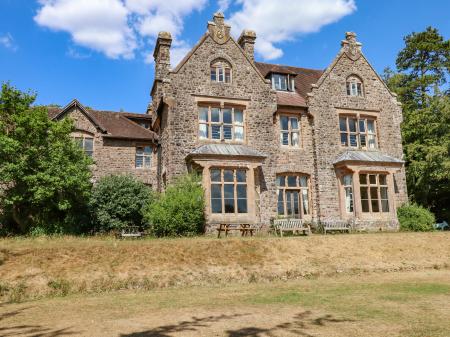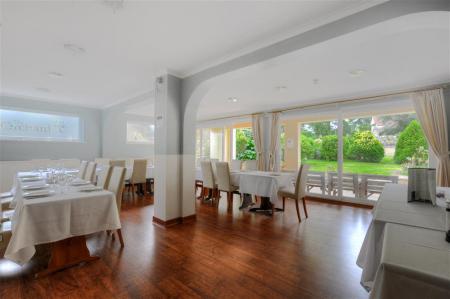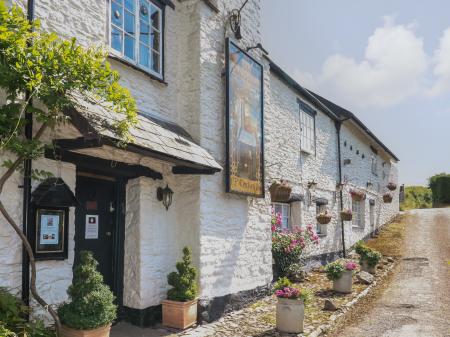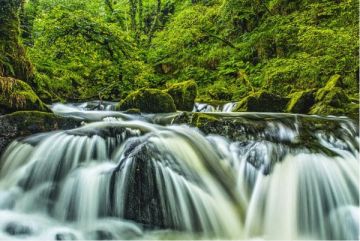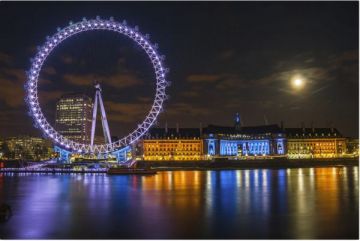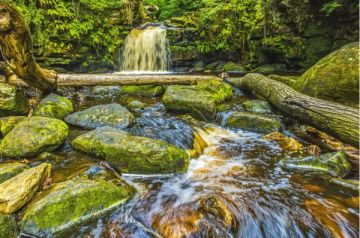Our family has just returned from a wonderful week exploring Dartmoor. I took over 2400 photos on this visit (our third). Out of curiosity, I decided to look through all my photos of Dartmoor and see which ones I thought were the best. I was trying to select my favourite 10 photos but I just couldn't cut down the list to 10, and ended up with 17 instead!
Well, since I've done that, why not share them with you? So here are my 17 favourite photos of Dartmoor, a mix of dramatic landscapes, beautiful scenery, historic sites, picturesque villages, and of course, Dartmoor ponies. I hope you enjoy these photos as much as I enjoyed taking them, and that you'll start your own collection of favourite images by exploring Dartmoor for yourself. And please - share your own favourites on our Facebook page!
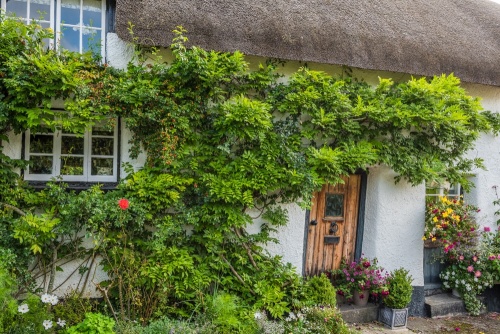
In my opinion, there are three candidates for the title of 'Prettiest Village in Dartmoor'; Lustleigh, Widecombe-in-the-Moor and Dunsford. Which village gets the nod is an open question, but Dunsford is certainly in contention.
The village is full of beautiful thatched cottages dating from the 16th to the 18th century. There are 67 listed buildings in Dunsford and many of them are attractive cob and thatch cottages like this example.
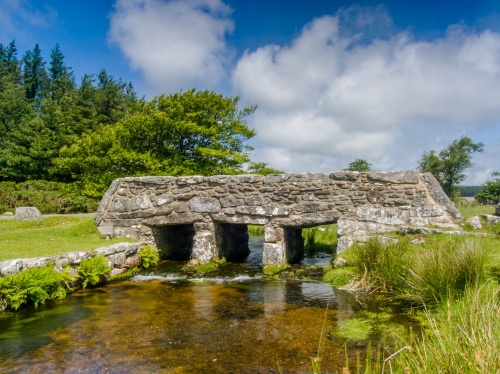
I was on my way to photograph Bellever Tor when I passed this picturesque bridge at Cator, a mile to the east. It is not a clapper bridge, though the stone piers certainly look as though they may have supported huge granite slabs at some point in the past. The bridge carries the minor road to Bellever over Walla Brook.

Dartmoor ponies are one of the most appealing highlights of any visit to the National Park. The ponies run wild and are a protected species. You can see them anywhere - and everywhere. I discovered a herd of ponies when I walked from Sheepstor to the prehistoric site of Scorhill Stone Circle.
The ponies were grazing happily among the standing stones. They looked apprehensive as I began to approach so I stopped and photographed from a distance before they eventually moved on. This particular pony kept a close eye on me to make sure I wasn't a threat.
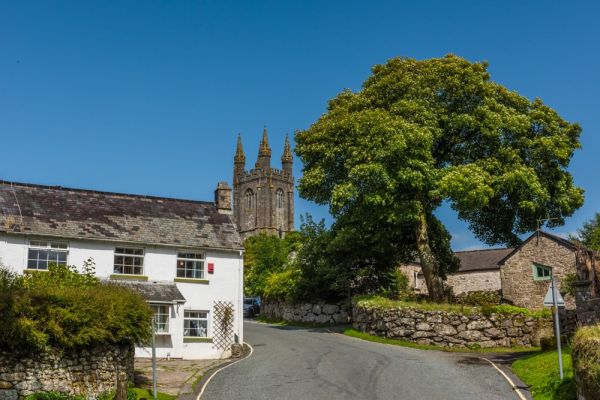
I mentioned Widecombe-in-the-Moor earlier - and with good reason. It is one of the prettiest villages in Devon and an absolute delight to explore. Even though it is a popular destination for visitors it still retains an air of timeless charm. I could have chosen any number of photos but I selected this view, showing a pretty cottage with the tower of St Pancras Church beyond.
The church is known as the Cathedral of the Moors, a testament to its size and its strikingly tall tower, which can be seen for miles around. The National Trust owns Church House, a beautifully restored medieval building that now acts as the village hall.
Widecombe is best-remembered for the popular West Country song about its annual fair - which is still held. The song tells the story of a group of 8 poor locals heading for the fair. They were so poor that they had just one horse between them.
After carousing at the fair they jumped on the horse's back - all eight of them at once. The poor beast managed to carry them up the hill out of Widecombe before it collapsed and died. One of the characters remembered in the song was 'Uncle Tom Cobley', a real person whose elaborately carved chair can be seen in the local gift shop.

Castle Drogo is one of the last great country houses built in England. The mock-Tudor mansion was designed by Sir Edward Lutyens for Julius Drewe, a wealthy merchant with aspirations to join the gentry. Construction began in 1910 and continued for another 20 years.
The Castle stands on a rocky outcrop overlooking the Teign Gorge, with fabulous views south and west over Dartmoor. A signposted trail leads along the top of the Gorge to Fingle Bridge, a 17th-century packhorse bridge over the River Teign. The route passes the viewpoint of Sharp Tor, where you can catch this glimpse of Castle Drogo from the edge of the Tor.

Bonehill Rocks is one of the numerous tors that define the Dartmoor landscape. Thee are several tors in the area around Widecombe-in-the-Moor, including Hay Tor, Rippon Tor, and Bonehill Rocks. I was staying for a week at a holiday cottage near Widecombe so I drove to the base of the tor and climbed to the summit in darkness to wait for the sunrise. I wasn't disappointed!

The historic village of Lydford lies on the western boundary of Dartmoor. Within a stone's throw of each other are a very, very early Christian church, a Norman fort and township, and the remains of Lydford Castle, once a notorious prison.
A short stroll from the castle lies the Castle Inn, a beautiful country pub that is, as you can see, popular with walkers and cyclists. Five minutes before I took this photo the ground was covered in snow, the result of a very sudden spring flurry. As quickly as the snow arrived, the sun came out and melted it away.

A short drive north of Lydford is Brentor, where you will find one of Dartmoor's iconic buildings, the medieval church of St Michael, perched on the summit of an exposed hilltop. Hilltop sites were often seen as sacred places and just as often you will find churches dedicated to St Michael on the summit of the hill. In this case, the church is dedicated to St Michael de Rupe. It is the 4th smallest parish church in England at just 40 feet long.
The church was built by a member of the Giffard family in thanks for being saved from drowning at sea during a storm. He vowed that if St Michael would spare his life he would build a church on the first point of land he saw, and Brentor Church is the result. During the medieval period, the church was owned by Tavistock Abbey. As for the tor itself, it is the last vestige of an ancient volcano.

I mentioned Fingle Bridge earlier (see Castle Drogo above). The bridge was built in the early 17th century and for over 200 years it carried the main road between Drewsteignton and the market town of Moretonhampstead to the south. It is one of the narrowest bridges on Dartmoor, at under 7 feet in width. It was never meant to carry large vehicles, but for heavily laden packhorses carrying grain, fish and timber to market.
Fingle Bridge became a popular beauty spot and a destination for tourists during the Victorian period. A tea shop was built on the north bank of the river to serve the tourist trade. That tea shop is now the Fingle Bridge Inn, a riverside pub that is justifiably popular with walkers and the many families that come to explore the river valley.
There are several popular walking trails on both banks of the river, including a classic circular trail to Castle Drogo and back, and another trail leading up to the Iron Age hillfort of Cranbrook Castle. I took this photo from the river bank by the Inn - before stopping with my family for a refreshing cider.

I had to include at least one photo of a Dartmoor clapper bridge. Clapper bridges are a common sight on Dartmoor. There are popular examples at Two Bridges and Dartmeet, to name just a few. Then there's this one at Postbridge, perhaps the most famous of all, spanning the East Dart.
The bridge may date to as early as the 12th century and is made of three large granite piers supporting four massive slabs, with a total span of over 42 feet.
Beside the medieval bridge is another bridge built in the 1780s to carry traffic between Moretonhampstead and Tavistock. Postbridge clapper bridge appears on numerous calendars and postcards and is one of Dartmoor's most popular visitor attractions - partly because it is so absurdly easy to reach.

Rippon Tor is one of the easiest tors to explore in Dartmoor. It lies just off the main road leading to Widecombe-in-the-Moor. In fact, that's where I was heading late one evening when I looked up and saw the last light of day hitting the summit of the tor. I pulled off the road - safely - and took this photo before the sun faded completely.

If you follow a footpath from the village of Manaton out onto the moor you come to a peculiar rock formation known as Bowerman's Nose. This rock column looks for all the world like a human head in profile, with a prominent chin and nose and cap. It comes with a legend attached (this is Dartmoor, after all).
It seems that a hunter named Bowerman was fond of leading his pack of hounds across the moor. He disturbed a coven of witches performing a ritual. The witches vowed revenge and lured the hunter into a trap where they cast a spell that turned him and his hounds into stone.
The people of Dartmoor were so angry that they drove the witches out of Devon. They fled to Wales, and the traditional Welsh tall hat worn by Welsh women was said to be inspired by the witches from Devon. As a result, there are no more witches in Dartmoor.

Hound Tor, near Manaton, is perhaps best-known for the deserted medieval village that lies on an exposed plateau south-east of the summit. The village is now in the care of English Heritage and consists of the foundation walls of several houses and outbuildings dating to the early medieval period.
There is a parking area on the minor road between Widecombe and Manaton, and a trail leads over the top of the tor. That was my destination one morning in April when I arrived before dawn hoping to see the tor lit by golden light. What I got was even better, as the dawn sky to the east turned shades of orange as the sun hit low clouds. It made getting up at 4 am worthwhile!

Outside Lydford village on the western edge of Dartmoor is Lydford Gorge, where the River Lyd tumbles down a steep, wooded gorge, now owned by the National Trust. There are waterfalls and bird hides, and beautiful trails along both sides of the gorge.
The most interesting feature, however, is the Devil's Cauldron, near the National Trust visitor centre at the eastern end of the gorge. Here the water cuts through a narrow channel and swirls around a wide, circular bowl in the rocks, creating a miniature whirlpool. Fringed by lush greenery, the Devil's Cauldron is stunning.

I said they were everywhere! You really can find Dartmoor ponies anywhere on the moors. Saddle Tor is a small outcrop of rock under the shadow of Hay Tor (Haytor), a few miles east of Widecombe. There are two pay and display parking areas which can be useful for climbing Haytor.
You often find Dartmoor ponies around the parking areas, and since they are accustomed to people you can often get reasonably close without spooking them. On this occasion, I actually came to climb Haytor at 5 am, but I couldn't pass up the chance to photograph one of the ponies in the beautiful early morning light. Rest assured that you don't have to get up that early to see Dartmoor ponies!

I couldn't pass up the chance to include a photo of Lustleigh, near Moretonhampstead. Lustleigh is often called the 'Prettiest village in Dartmoor', and with good reason. There are several picturesque thatched cottages around the triangular village green, a thatched teashop, and a beautiful medieval church with a magnificently carved screen dated to the reign of Mary I.

Drumroll, please .... Now we come to my favourite photo of Dartmoor, showing Haytor Rocks at sunrise. I got up absurdly early and drove to Haytor from the holiday cottage I was staying at near Widecombe-in-the-Moor. I climbed Haytor in the dark and set up my tripod to wait for the sunrise. The thing I remember most about that morning was that the wind was whistling over the tor and I was chilled to the bone.
Photography involves a lot of standing around doing nothing while waiting for the light, and standing around in the pre-dawn chill atop Haytor is not something I recommend unless you are clad in several layers of thermal underwear, three jackets, and two woolly hats (I wasn't). But it was worth it for this amazing view of the sun breaking through the clouds and silhouetting Haytor Rocks against the dawn sky.
There are so many beautiful places to see in Dartmoor National Park. These are just a few of my favourites. Now it's your turn!
MOST POPULAR POSTS
